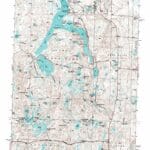Whitley County’s Geographic Information System (GIS) is a powerful tool, offering a wealth of information about properties, taxes, and the county’s landscape. Think of it as a dynamic, interactive map that unlocks valuable insights for homeowners, businesses, researchers, and anyone curious about their surroundings. This comprehensive guide will walk you through accessing and utilizing this resource, from finding the right website to understanding the various data layers.
Navigating Whitley County’s GIS Landscape
Accessing Whitley County’s GIS data is like opening a door to a vast library of information. The primary entry point is the Whitley County GIS Department website, your official source for all things GIS. Here you’ll find the interactive County Map Viewer, offering customizable searches, printable maps, and detailed property information. For a combined view of GIS maps with CAMA (Computer Assisted Mass Appraisal), assessments, and tax data, Beacon/qPublic.net provides a convenient, integrated platform. You can also explore supplementary resources like Rockingham GIS VA and Kershaw County SC GIS for further geographic data comparisons.
Exploring the Map Viewer: A User-Friendly Guide
The County Map Viewer is your window into Whitley County’s layout. Here’s a step-by-step guide to using its key features:
- Access the Viewer: Navigate to the Whitley County website and locate the Map Viewer link, typically under “Maps,” “GIS,” or a similar section.
- Orient Yourself: Familiarize yourself with the interface, noting the map, tools, and menus.
- Search and Explore: Search by address, parcel number, or points of interest. Use zoom and pan controls to navigate.
- Layer the Data: Overlay different data layers (like zoning or floodplains) via the layer control menu.
- Print Your Map: Create customized, printable maps displaying specific information.
Diving into Data Layers: Uncovering Hidden Information
Data layers are like transparent overlays on the base map, each revealing different information. Some common layers and their uses include:
| Data Layer | Potential Uses |
|---|---|
| Parcels | Determining property boundaries, ownership, acreage, and unique parcel numbers. |
| Zoning | Understanding land-use regulations and permitted activities for development and compliance. |
| Floodplains | Identifying areas at risk of flooding for risk assessment and insurance purposes. |
| Tax Assessment | Accessing property tax valuations and history via Beacon/qPublic.net for understanding property values. |
| Infrastructure | Locating existing and planned infrastructure (roads, utilities) for planning and understanding available services. |
| Environmental | Identifying environmentally sensitive areas and protected habitats for conservation and impact studies. |
| Topography | Understanding land contours and elevation for construction, water flow analysis, and other applications. |
| Urban Planning | Accessing land use and zoning regulations for development and future planning. |
Working with Parcel Data: Splits and Discrepancies
The Whitley County GIS Department diligently maintains parcel data, including address creation. However, changes like parcel splits can occur. The county has a specific policy for these splits, ensuring accurate record-keeping. If you encounter discrepancies, a reporting process exists to request updates, contributing to data reliability. For detailed information, consult the County’s official website or contact the GIS Department directly. Remember that data is constantly evolving, so periodic checks are recommended. It’s also wise to acknowledge potential biases or limitations in any dataset. While accuracy is a priority, data may be incomplete, or subject to ongoing updates.
Third-Party Resources: A Supplemental Perspective
Independent platforms like AcreValue and CountyOffice.org often provide supplemental information, such as historical data or sales information. While these resources can enhance research, they are not officially affiliated with the county government and may not always be entirely up-to-date. For critical decisions, prioritize official Whitley County GIS data. It’s important to consider different perspectives, but remember the county’s data remains the primary source.
The Future of Whitley County GIS
Whitley County GIS is continually evolving, with ongoing research and development suggesting future enhancements like improved search functions, mobile-friendly interfaces, and richer data layers. New data may be added, and existing data might be updated or refined, so staying up-to-date with official sources ensures access to the most accurate and current information.
Need Assistance?
For questions or assistance navigating Whitley County GIS, contact the GIS Department directly. They can provide personalized support and guide you through specific processes, from using the Map Viewer to understanding complex data layers. They are the best resource for inquiries about parcel splits, discrepancy reporting, or accessing specific datasets.
- Unlock Water’s Symbolism: A Cross-Cultural Exploration - April 20, 2025
- Identify Black and White Snakes: Venomous or Harmless? - April 20, 2025
- Unlocking Potential: Origins High School’s NYC Story - April 20, 2025















